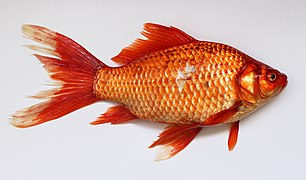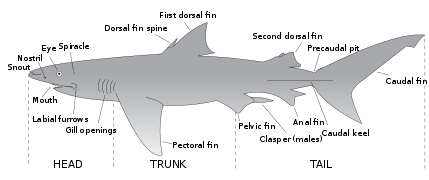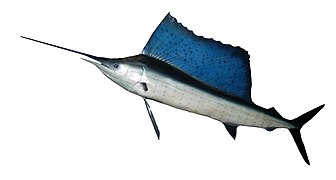Dorsal fin

A dorsal fin is a
Wildlife biologists often use the distinctive nicks and wear patterns which develop on the dorsal fins of large cetaceans to identify individuals in the field.
The bony or cartilaginous bones that support the base of the dorsal fin in fish are called pterygiophores.
Functions
The main purpose of the dorsal fin is to stabilize the animal against rolling and to assist in sudden turns. Some species have further adapted their dorsal fins to other uses. The
-
Most fish, like this large goldfish, have one dorsal fin
-
Sharks typically have two dorsal fins
-
The yellowfin tuna also has two dorsal fins
-
Haddocks have three dorsal fins
Billfish have prominent dorsal fins. Like tuna, mackerel and other scombroids, billfish streamline themselves by retracting their dorsal fins into a groove in their body when they swim.[1] The shape, size, position and colour of the dorsal fin varies with the type of billfish, and can be a simple way to identify a billfish species. For example, the white marlin has a dorsal fin with a curved front edge and is covered with black spots. The huge dorsal fin, or sail, of the sailfish is kept retracted most of the time. Sailfish raise them if they want to herd a school of small fish, and also after periods of high activity, presumably to cool down.[1][2]
-
Differences of dorsal fins of orcas between male and female
-
The dorsal fin of a white shark containsdermal fibers that work "like riggings that stabilize a ship's mast", and stiffen dynamically as the shark swims faster to control roll and yaw.[3]
-
Large retractable dorsal fin of the Indo-Pacific sailfish
-
Various species ofIchthyosaursdisplaying different types of dorsal fins
Structure
A dorsal fin is classified as a
-
Dorsal fin of a perch showing the basals and radials of the pterygiophore that support the dorsal fin.
-
Closeup of the dorsal fin of a common dragonet
See also
- Shark fin soup
- Submarine sail
- Vertical stabilizer
Notes
- ^ ISBN 9780761471707.
- ^ Dement J Species Spotlight: Atlantic Sailfish (Istiophorus albicans) littoralsociety.org. Retrieved 1 April 2012.
- ]
- ^ S2CID 13621022.
- ^ a b c Barton, Michael (2007). Bond's Book of Fish (3rd ed.). The Thompson Corporation. pp. 37–39, 60–61.






![The dorsal fin of a white shark contains dermal fibers that work "like riggings that stabilize a ship's mast", and stiffen dynamically as the shark swims faster to control roll and yaw.[3]](http://upload.wikimedia.org/wikipedia/commons/thumb/e/e5/White_shark_%28cropped%29.jpg/309px-White_shark_%28cropped%29.jpg)




